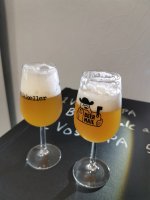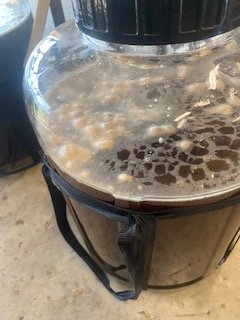Protos
Die Schwarzbier Polizei
I don't think the time of the year matters for harvesting juniper. If we look at the pictures from Norwegian farmhouse brewing reports, they brew both in summer and in winter, always using fresh juniper branches.

You can pull the plug on the heat as soon as it hits FG. For my 3G batches I’m stopping the heat about 36 hours after pitching the yeast.This has been a great little thread so far. Thank you.
There's so many conflicting opinions of Voss, is hard to make heads or tails. What it seems like to me is that brewers get sold on the marketed fast, fast, fast and then disappointed by what is really a very green beer.
I'm going to go ahead with my very simple pale ale probably on Wednesday. Will ferment at a steady 95°. I'm in no rush to bottle, so it'll probably see 2-3 weeks in the primary. From what I'm getting from you all, that's the key. Time to condition. Probably a week at 95, then pull the plug on the heat until I'm ready to bottle.
I think it's desirable to lower the temperature asap after fermentation finished, as staling processes and other negative developments are accelerated the higher the temperature is.You can pull the plug on the heat as soon as it hits FG. For my 3G batches I’m stopping the heat about 36 hours after pitching the yeast.
What it seems like to me is that brewers get sold on the marketed fast, fast, fast and then disappointed by what is really a very green beer.
Voss produces sulphur at low temperatures, and as the temperature gets higher the sulphur is driven off and more of the yeast's natural character shows through.
If you don't give the yeast lots of nutrition I have found it to produce a more earthy, slightly spicy orange peel note. However, if you give Voss lots of nutrition, and keep it hot, then the esters are far more along the lines of orange blossom, and are rather pretty.
Found the needles in a German online shopI bitter my kveiks and sahtis with dried juniper needles I buy in health stores. Adding berries was not authentic, Garshol specifically stressed in some publication.
IDK whether you can buy dried juniper needles in Germany, but Germany is blessed with that the authentic Juniperis communis is the wild juniper there, unlike in USA or here in Southern Europe, where a lot of different poisonous species grow along.















Great! Now the most difficult part: defining how much you need. I found zero suggestions on that matter in even the most detailed books and blogs. They recommend "a medium-size branch" at best. Not knowing much of juniper branch grading in Scandinavian countryside, I needed to experiment. Dried juniper is less potent than fresh, so a dose visually roughly assessed as the dry equivalent to a "medium-sized branch" didn't add much flavour to my ales. So I experimented further, and now I use 15 g dried needles to 1 L of liquor, boiling them for 15 minutes. Initially it gives a fantastic piney aroma and a kind of gruit-like herbal bitterness. However, both aroma and flavour aren't lasting and greatly mellow during fermentation. 15 g/1L will add a nice touch complimenting kveik yeast esters, but won't be enough to bitter a hop-less beer.Found the needles in a German online shop
My impression is that the heavier the wort the better results Voss kveik produces. My only decent kveik ales were very strong and heavily-junipered. Which, in fact, well corresponds with the intended use of the strain.Typically brew IPA'S and RIS.
Nice, what was the best amount of needles per litre for your stronger beers without hops?Great! Now the most difficult part: defining how much you need. I found zero suggestions on that matter in even the most detailed books and blogs. They recommend "a medium-size branch" at best. Not knowing much of juniper branch grading in Scandinavian countryside, I needed to experiment. Dried juniper is less potent than fresh, so a dose visually roughly assessed as the dry equivalent to a "medium-sized branch" didn't add much flavour to my ales. So I experimented further, and now I use 15 g dried needles to 1 L of liquor, boiling them for 15 minutes. Initially it gives a fantastic piney aroma and a kind of gruit-like herbal bitterness. However, both aroma and flavour aren't lasting and greatly mellow during fermentation. 15 g/1L will add a nice touch complimenting kveik yeast esters, but won't be enough to bitter a hop-less beer.
My impression is that the heavier the wort the better results Voss kveik produces. My only decent kveik ales were very strong and heavily-junipered. Which, in fact, well corresponds with the intended use of the strain.
And all my Voss beers lower than 1.080 have been just meh.
I've brewed with Lallemand Voss three times, and I don't think I will use it again.
I am an all-grain brewer with Spike conicals and a glycol chiller & heater, so stable temp control from 36F to 105F isn't a problem at all. Each Voss brew fermented aggressively and quickly at 85F and higher, but one almost stalled when started at the bottom of the temp range. This yeast likes it hot. Pressurization doesn't seem to make much difference in slowing it down or the results. Rehydration didn't seem to make much if any difference, so just pitching straight from the packet worked well.
Though crazy quick fermenters, each brew had a DMS-like component that would diminish with 4+ weeks after kegging, resulting in a ester-y English yeast flavor contribution. The DMS-like addition happened all three times, and I don't get DMS in my brews. To wait the 4+ weeks for the DMS-like component to drop out eliminated any benefit the quick fermentation provided. I get quick enough fermentations with 'normal' yeasts that are pitched from a healthy starter, and none of the downsides. That said, the Voss Xmas brew I did last Nov for the holidays turned out quite nice by later December.
I've also used Lutra and Hornindal, and neither of those had the same DMS-like issues, and I will use those again in the future. YMMV.
They were 1.071, 1.056 and 1.067 (which was the Xmas Ale).What were the gravities of the three not-so-good batches? I imagine the Xmas brew was a bigger celebration beer?
In the fermenter, Lallemand Voss pitched dry at 93, temp control set at 95.
1.065 MO/Optic/GP blend
35IBU Mittlefrüh, 1oz FWH, 1.3oz 60m
Tastes great now. I'll keep y'all updated.
ETA: Pitched 2.5hrs ago, inch thick krausen!
36hrs post-pitch. 81.5% attenuation 1.065->1.012. Very, very slow airlock movement.
The one watch-out for me, was that as it had fermented so quickly, there was not enough active yeast left to carbonate the bottles and my beer was quite flat. Not sure what to do about that next time, maybe add a small amount of a dry yeast pack to my bottling bucket....but how much ?
Will you post what final gravity it reached when it is ready? My chocolate porterish beer went from 1.090 to 1.030 (tempearture adjusted) and I used Mangrove Jacks m12 Kveik yeast which is said to be also of Voss variety.I've got a kettle full of Mittlefrüh FWH and 100% UK base malt 1.090 1st runnings.
Smells wonderful!!!
Will you post what final gravity it reached when it is ready? My chocolate porterish beer went from 1.090 to 1.030 (tempearture adjusted) and I used Mangrove Jacks m12 Kveik yeast which is said to be also of Voss variety.
I kegged a hazy IPA yesterday brewed with Lallemand Voss, fermented at 35c (95f). Hops Citra & Simcoe.
It was done within 24h of fermentation, I let it sit at 35c for an additional day, then I removed the heating and let it come to room temp over a day, then soft crash to 15c (59f) and dry hop for 24h.
Then cold crash 2 days until everything dropped. So it was 6 days in the fermenter in total. I haven't tasted it from the keg yet, might do that tomorrow, but the sample definitely had orange in the aroma and taste, and I thought it tasted pretty good. I can report back when I've had a proper taste of the more finished product.


I brewed with lallemend kviek Voss yeast it was a total beast grain to glass in 6 days. I made an IPA with citra and Amarillo which both should taste like citrus but it has a distinctly orange kinda fake flavor. Did anyone else experience this I don’t think the flavor is the hops I’m not sure I’d use this yeast again.
Depending on how low the mineral content of the ro water is, this will likely kill a portion of the yeast cells due to osmotic pressure. The cells just burst. Luckily, kveik needs only a very small cell count. But in general, it is a bad idea to rehydrate in ro or distilled water without the addition of salts and/or nutrients.I’ve over seven the kveik Voss often starts visible fermentation within two hours of pitching. I’ve also found soaking it in RO water for 15 minutes speeds this up.